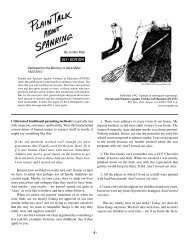By Jordan Riak - Project NoSpank
By Jordan Riak - Project NoSpank
By Jordan Riak - Project NoSpank
Create successful ePaper yourself
Turn your PDF publications into a flip-book with our unique Google optimized e-Paper software.
The pornography and prostitution industries do a thriving business catering<br />
to the needs of countless unfortunate individuals whose sexual development<br />
has been derailed by childhood spankings. If we put all other considerations<br />
aside, this should be reason enough never to spank a child.<br />
The physical dangers of hitting the buttocks<br />
Located deep in the buttocks is the sciatic nerve, the largest nerve in the<br />
body. A severe blow to the buttocks, particularly with a blunt instrument,<br />
could cause bleeding in the muscles that surround that nerve, possibly injuring<br />
it and causing impairment to the involved leg. .<br />
In addition to nerve damage and soft tissue damage, a blow to the buttocks<br />
can cause injury to the tailbone (coccyx) or sacrum. It sends force waves<br />
upward through the spinal column possibly causing disc compression or<br />
compression fractures of vertebral bones.<br />
Some people, in their attempt to justify battering children’s buttocks, claim<br />
that God or nature intended that part of the anatomy for spanking.<br />
That is a brazenly perverse claim. No part of the human body was made to<br />
be mistreated. ..<br />
Physical danger of hitting the hands .<br />
The child’s hand is particularly vulnerable because its ligaments, nerves, tendons<br />
and blood vessels are close to the skin, which has no underlying protective<br />
tissue. Striking the hands of younger children is especially dangerous to the<br />
growth plates in the bones, which, if damaged, can cause deformity or impaired<br />
function. Striking a child’s hand can also cause fractures, dislocations and<br />
lead to premature osteoarthritis. .<br />
WHAT THE EXPERTS SAY<br />
“If we really want a peaceful and compassionate world, we need to build<br />
communities of trust where all children are respected, where home and school<br />
are safe places to be and where discipline is taught by example.”<br />
Desmond M. Tutu, Archbishop Emeritus, Global Initiative to End All<br />
Corporal Punishment of Children, 2006.<br />
See www.nospank.net/globalreport.pdf.<br />
“The claim that mild punishment (slaps or smacks) have no detrimental<br />
effect is still widespread because we received this message very early<br />
from our parents who had taken it over from their parents. Unfortunately, the<br />
main damage it causes is precisely the broad dissemination of this conviction.<br />
The result is that each successive generation is subjected to the tragic effects<br />
of so-called ‘physical correction.’ . . . Physical cruelty and emotional<br />
humiliation not only leave their marks on children, they also inflict a disastrous<br />
imprint on the future of our society. Information on the effects of the “wellmeant<br />
smack” should therefore be part and parcel of courses for expectant<br />
mothers and of counseling for parents.” .<br />
Alice Miller, Excerpt from: “Every Smack is a Humiliation,” 1998.<br />
See www.nospank.net/miller3.htm.<br />
Shaking .<br />
“A society with little or no hitting of children is likely to result in fewer people<br />
who are alienated, depressed, or suicidal, and in fewer violent marriages. The<br />
potential benefits for the society as a whole are equally great. These include<br />
lower crime rates, especially for violent crimes; increased economic<br />
productivity; and less money spent on controlling or treating crime and mental<br />
illness... A society that brings up children by caring, humane, and non-violent<br />
Being shaken can cause a child blindness, whiplash, brain damage, spinal<br />
methods is likely to be less violent, healthier, and wealthier.”<br />
cord injury and even death. .<br />
Murray Straus, Co-Director of the Family Research Laboratory<br />
at the University of New Hampshire. From “A Society Without<br />
Spanking at home, performance at school .<br />
Perceptive teachers will tell you that the children who exhibit the most serious<br />
Corporal Punishment.” See www.nospank.net/straus5.htm.<br />
behavior problems at school also have the most troubled home environments.<br />
“The most positive social changes around the world have followed mass<br />
For many of these children, the battle zone which is their home life carries<br />
improvements in the way children are treated.”<br />
over into their school life. This sets them up for academic failure and dropout.<br />
Robin Grille, author of Parenting for a Peaceful World, 2005.<br />
In their attempt to erect a shield against what they see as a comfortless,<br />
hostile world, these children naturally seek the company of other children<br />
with similar problems. Street gangs evolve to fill the void left by failed home<br />
life and failed school life.<br />
“Children should never receive less protection than adults. . . [we must] put<br />
an end to adult justification of violence against children, whether accepted as<br />
‘tradition’ or disguised as ‘discipline’.”<br />
6<br />
.<br />
11





